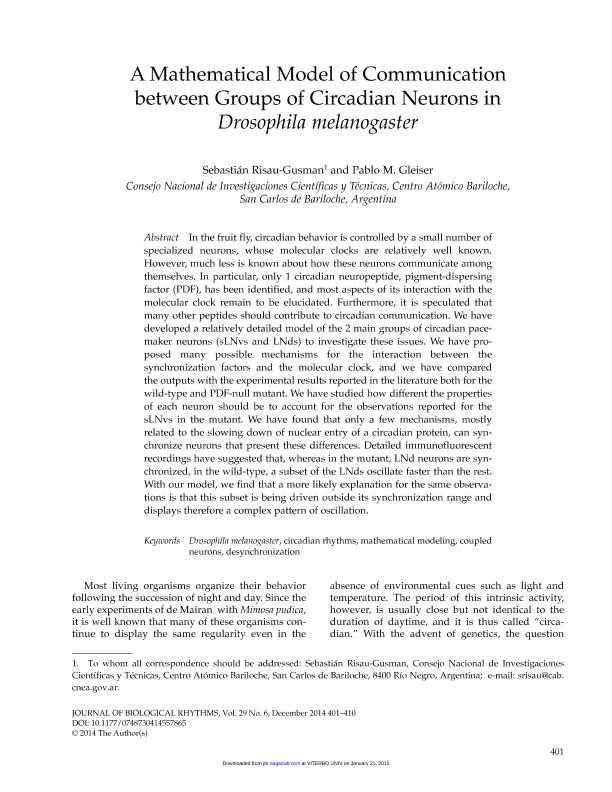Mostrar el registro sencillo del ítem
dc.contributor.author
Risau Gusman, Sebastian Luis

dc.contributor.author
Gleiser, Pablo Martin

dc.date.available
2018-01-23T17:29:13Z
dc.date.issued
2014-11
dc.identifier.citation
Risau Gusman, Sebastian Luis; Gleiser, Pablo Martin; A Mathematical Model of Communication between Groups of Circadian Neurons in Drosophila melanogaster; Sage Publications; Journal of Biological Rhythms; 29; 6; 11-2014; 401-410
dc.identifier.issn
0748-7304
dc.identifier.uri
http://hdl.handle.net/11336/34281
dc.description.abstract
In the fruit fly, circadian behavior is controlled by a small number of specialized neurons, whose molecular clocks are relatively well known. However, much less is known about how these neurons communicate among themselves. In particular, only 1 circadian neuropeptide, pigment-dispersing factor (PDF), has been identified, and most aspects of its interaction with the molecular clock remain to be elucidated. Furthermore, it is speculated that many other peptides should contribute to circadian communication. We have developed a relatively detailed model of the 2 main groups of circadian pacemaker neurons (sLNvs and LNds) to investigate these issues. We have proposed many possible mechanisms for the interaction between the synchronization factors and the molecular clock, and we have compared the outputs with the experimental results reported in the literature both for the wild-type and PDF-null mutant. We have studied how different the properties of each neuron should be to account for the observations reported for the sLNvs in the mutant. We have found that only a few mechanisms, mostly related to the slowing down of nuclear entry of a circadian protein, can synchronize neurons that present these differences. Detailed immunofluorescent recordings have suggested that, whereas in the mutant, LNd neurons are synchronized, in the wild-type, a subset of the LNds oscillate faster than the rest. With our model, we find that a more likely explanation for the same observations is that this subset is being driven outside its synchronization range and displays therefore a complex pattern of oscillation.
dc.format
application/pdf
dc.language.iso
eng
dc.publisher
Sage Publications

dc.rights
info:eu-repo/semantics/openAccess
dc.rights.uri
https://creativecommons.org/licenses/by-nc-sa/2.5/ar/
dc.subject
Drosophila Melanogaster
dc.subject
Circadian Rhythms
dc.subject
Mathematical Modeling
dc.subject
Coupled Neurons
dc.subject.classification
Astronomía

dc.subject.classification
Ciencias Físicas

dc.subject.classification
CIENCIAS NATURALES Y EXACTAS

dc.title
A Mathematical Model of Communication between Groups of Circadian Neurons in Drosophila melanogaster
dc.type
info:eu-repo/semantics/article
dc.type
info:ar-repo/semantics/artículo
dc.type
info:eu-repo/semantics/publishedVersion
dc.date.updated
2018-01-23T14:09:42Z
dc.journal.volume
29
dc.journal.number
6
dc.journal.pagination
401-410
dc.journal.pais
Estados Unidos

dc.description.fil
Fil: Risau Gusman, Sebastian Luis. Comisión Nacional de Energía Atómica. Centro Atómico Bariloche; Argentina. Consejo Nacional de Investigaciones Científicas y Técnicas; Argentina
dc.description.fil
Fil: Gleiser, Pablo Martin. Comisión Nacional de Energía Atómica. Centro Atómico Bariloche; Argentina. Consejo Nacional de Investigaciones Científicas y Técnicas; Argentina
dc.journal.title
Journal of Biological Rhythms

dc.relation.alternativeid
info:eu-repo/semantics/altIdentifier/doi/http://dx.doi.org/10.1177/0748730414557865
dc.relation.alternativeid
info:eu-repo/semantics/altIdentifier/url/http://journals.sagepub.com/doi/10.1177/0748730414557865
Archivos asociados
